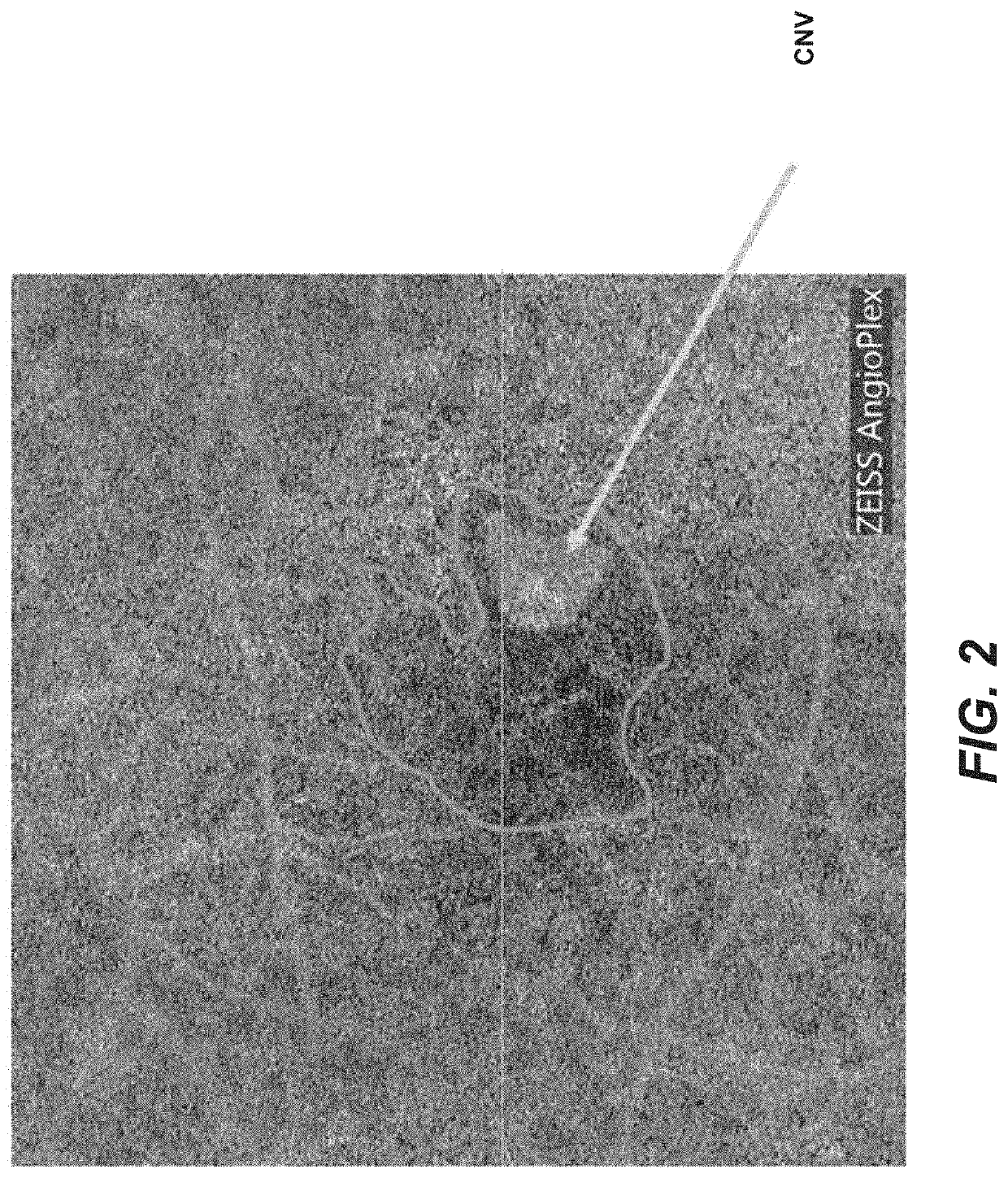Non-leaking or minimally-leaking choroidal or retinal revascularization
a choroidal or retinal revascularization, non-leaking or minimally-leaking technology, applied in the field of ocular diseases, can solve the problems of increasing non-leaking or minimally-leaking choroidal perfusion, and reducing the hypoxia of the outer retina and so as to reduce the hypoxia of the retina of the eye of the subject, the effect of reducing the void
- Summary
- Abstract
- Description
- Claims
- Application Information
AI Technical Summary
Benefits of technology
Problems solved by technology
Method used
Image
Examples
example 1
Non-Leaking Choroidal Neovascularization Protects Overlying Tissue from Developing Geographic Atrophy
[0122]There is clinical support for the hypothesis that a mature neovascular network underneath the fovea can support normal foveal architecture and prevent development of geographic atrophy. OCT angiography has shown that patients with type 1 CNV (sub-RPE) underneath the fovea develop GA eccentric to the retina overlying the neovascularization, suggesting that the CNV maintains the viability of the overlying macular tissue.
[0123]An example of this is shown below in an 88 year-old subject with disciform scar OS. The subject had received numerous injections in OD until he got post-injection endophthalmitis one year previous to the OCT angiography study shown in FIG. 3. The OCT and OCT angiogram reveal subfoveal CNV that is non-leaking (Let's show a picture of the OCT, too; don't' have it). Then, he did not want to have further injections, He has had no exudation nor progression of atr...
example 2
AMD with Progressively Expanding Extrafoveal Geographic Atrophy (GA)
[0124]A patient with AMD, good central visual acuity (≥20 / 40) and early GA that spares fixation is considered for treatment with pro-angiogenic therapy. OCTA examination reveals macular flow voids indicating reduced choriocapillaris perfusion. Pro-angiogenic compound(s) is / are administered intravitreally. Alternatively, pro-angiogenic therapy can be administered by a suprachoroidal route or injected into the subretinal space in the macular region. Following pro-angiogenic therapy, the patient is followed by sequential ocular examination, including visual acuity assessment, fundus auto-fluorescence (FAF), OCT and OCTA examinations. On follow up, GA progression is halted or slowed as demonstrated by serial FAF and OCT examination. OCTA demonstrates reduction in macular flow voids, including at the margin of the existing GA lesion(s). If during follow-up there is progressive choriocapillaris attrition with progression ...
example 3
AMD with CNV
[0125]OCTA in patients with CNV shows increased flow voids (choriocapillaris perfusion defects) surrounding the neovascular membrane. Resultant hypoxia results in VEGF secretion by RPE with subsequent CNV development. After treatment with anti-VEGF agents, CNV usually shows reduction in permeability. To minimize exudation and visual loss, repeated anti-VEGF injections are required. As an alternative, angiogenic factors that promote non-leaking choroidal neovascularization, reduce ischemia and resultant need for frequent VEGF injections. Pro-angiogenic choroidal revascularization therapy reconstitutes choriocapillaris and eliminates the ischemic drive for VEGF secretion. A patient with wet AMD is initially treated with an anti-VEGF agent that stops leakage from choroidal neovascularization. At the same time or shortly thereafter, a pro-angiogenic factor is administered intravitreally or subretinally, or in the suprachoroidal space, which promotes non-leaking choriocapilla...
PUM
| Property | Measurement | Unit |
|---|---|---|
| optical coherence tomography | aaaaa | aaaaa |
| optical coherence tomography angiography | aaaaa | aaaaa |
| composition | aaaaa | aaaaa |
Abstract
Description
Claims
Application Information
 Login to View More
Login to View More - R&D
- Intellectual Property
- Life Sciences
- Materials
- Tech Scout
- Unparalleled Data Quality
- Higher Quality Content
- 60% Fewer Hallucinations
Browse by: Latest US Patents, China's latest patents, Technical Efficacy Thesaurus, Application Domain, Technology Topic, Popular Technical Reports.
© 2025 PatSnap. All rights reserved.Legal|Privacy policy|Modern Slavery Act Transparency Statement|Sitemap|About US| Contact US: help@patsnap.com



